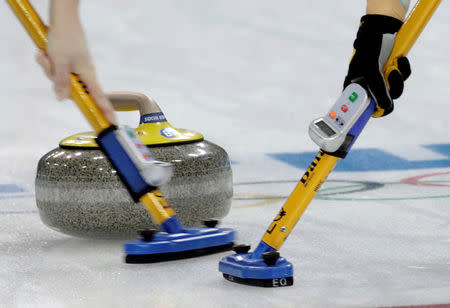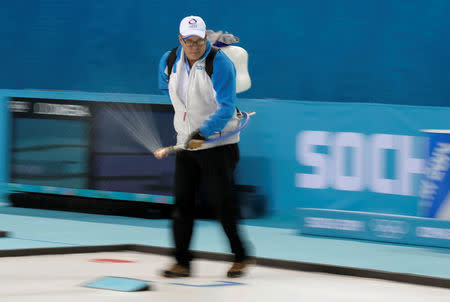Olympics: A level playing field, with pebbles
By Alan Baldwin MAUCHLINE, Scotland (Reuters) - Mark Callan recoils at the idea of a Zamboni ever being driven out onto one of his curling sheets. The popular ice grooming machine used at skating rinks and hockey matches has no place in a sport that can claim to provide the most level playing field of any at the Winter Olympics, and one of the most technical. "That would be like trying to shave with a Flymo," said the Scot, referring to a brand of lawn mower, of the very suggestion. Callan is a director of the Kays Curling company that makes the Olympic stones but also an ice technician who will be in Pyeongchang for both the Olympic Games and subsequent Paralympics. In his world, there's ice and there's curling ice -- harder, purer, flatter and with crucial 'pebbles' on the surface. "Curling ice is quite a lot different to regular ice that you would have figure skating or hockey on, because it has to be 100 percent level," he told Reuters at the Kays factory in Mauchline. "With curling ice it is absolutely imperative that the ice is completely flat. If it isn’t, then it destroys the game. The curling stones that we use are designed to curl -- bend -- on the ice. "Twenty kilos of granite sliding up the ice is not going to defeat gravity and climb up a hill." Modern equipment can measure the level of the ice surface to within 0.01 of a millimeter. Then there are the 'pebbles', created by sprinkling tiny droplets of water onto the gleaming ice, that freeze instantly and allow the stones to glide and curl in a way they would not otherwise. "The roughness of the (stone's) running surface and the quality of the pebble will determine how much the stone can curl," explained Callan. This is because the pebbled surface, which can be likened to the peel of an orange in terms of texture, combines with the stone's concave bottom to create a micro-layer of water and reduce friction. PEBBLE HEAD Players also sweep the surface with brushes, with the game changing as the pebbles melt or wear down and affect the stone's movement. "The stone runs on little beads of water and that's where the skill of the icemaker comes in into making sure that (the pebbling) is applied evenly and consistently across the sheet," said Callan. He walks up and down with a backpack, "like something you would maybe have for spraying wheat or crops or fertilizer", and a 'pebble head' that distributes droplets through holes that can vary in size. As a rough rule of thumb, the colder the ice surface the warmer the water in the can and every sheet is given two pebbles prior to the game, one in each direction to ensure there is no inconsistency. The ice itself is made in the same way as other rinks, with very thin layers -- each two to three millimeters thick -- built up to ensure no oxygen is left trapped inside. Only de-ionised water is used, a process that removes any chemicals such as chlorine or fluorine found in tap water. "It freezes very quickly and because it freezes so quickly, it freezes very hard. And that makes it ideal to provide a running surface for curling," said Callan. A machine with a blade sharpened to be 100 percent flat and accurate is worked over the ice in pre-determined patterns known as 'scraping' to ensure that the surface is completely level. After this comes the pebbling. And once a game is done, the preparation work starts over. "During a game you’ve got up to eight players all sliding about on it (the ice) and sweeping and the stones running up and down," said Callan. "So to make sure it’s fair and equitable all the way across, when a game is finished all of that is scraped off and we start again." Every building is different, with the number of people likely to be inside also dictating how cold the ice needs to be. Too warm and the pebbles will wear faster, too cold and the stone reacts differently. "I’ve just come back from Korea where our outside average temperature was -8 (Celsius) and the air temperature inside the arena was +10 at head height and the ice surface temperature was -5.2," said Callan. "If you’re in an arena and 3,000 people walk in the door all wrapped up in jackets and suddenly all of this heat is inside, you have to be ready for that." (Editing by Amlan Chakraborty)

 Yahoo Sports
Yahoo Sports 


